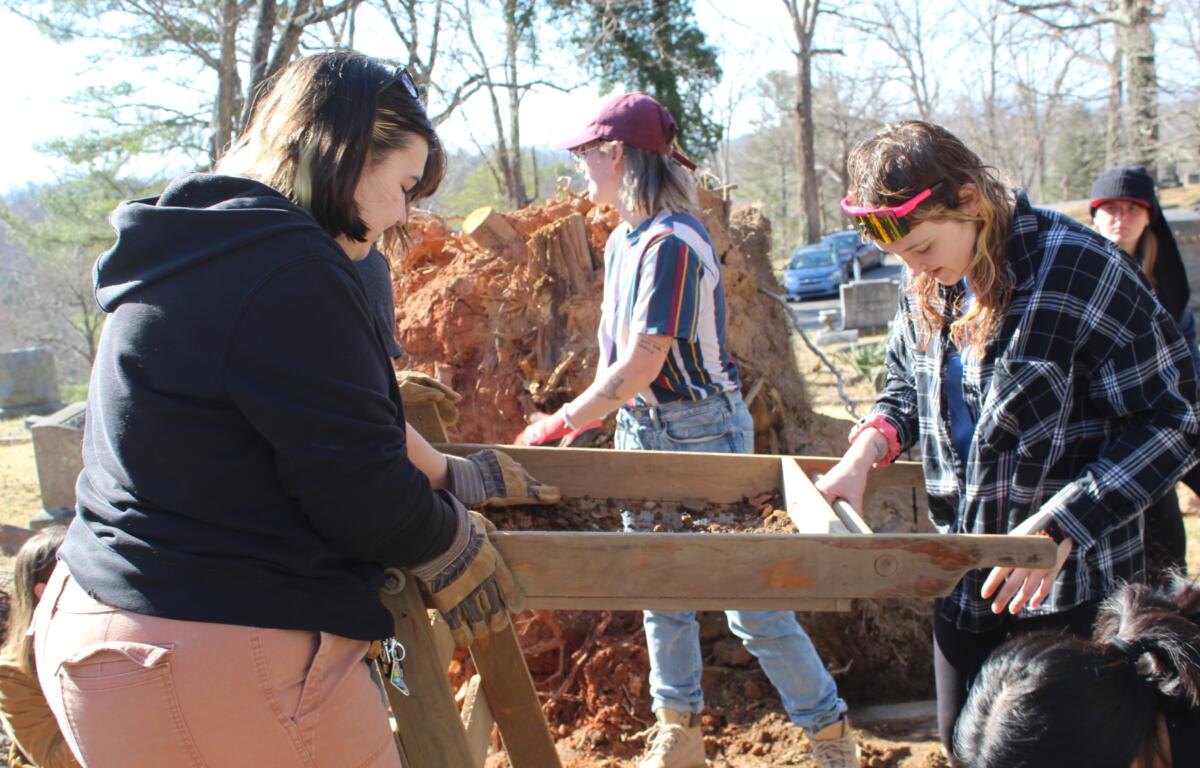ASHEVILLE, N.C. (828newsNOW) — Riverside Cemetery is a historic burial ground nestled among the hills along the French Broad River in the Montford District.
Huge trees, many more than 100 years old, shade the thousands of graves in the 87-acre burial place. But Tropical Storm Helene brought down many of the trees, disrupting several grave sites.
Because of the damage to the graves, the city of Asheville has been working with Western Carolina University’s forensic anthropology program, whose students are assessing the historical and cultural damage at Riverside Cemetery.
The students, who are on spring break, began the assessment process Friday.
Parks and Recreation’s Jonathan Neary said the damage at Riverside Cemetery was widespread with about 132 graves damaged by falling trees.
Sifting soil
Western Carolina University anthropology professor Dr. Ben Steere said the students are working around the rootballs of the trees that fell across the cemetery.
“We’re recording location information, kind of doing damage assessment, understanding how badly each of these locations was damaged,” Steere said. “And then what we’re going to do is make a recommendation for each of these locations and indicate whether, you know, there has been damage and this place is going to require additional archaeological monitoring when they actually remove the stumps.”

On Monday, the students were sifting dirt from under a rootball beside a cluster of graves.
“It’s just some of the soil that we removed from these tombstones that got flipped back up. So what they might find here are just where people have brought things through the years like jars of flowers and things like that,” Brett Riggs, professor in Western Carolina University’s Department of Anthropology and Sociology, said while the students worked behind him.
Riggs, the Sequoyah Distinguished Professor of Cherokee Studies at Western Carolina University, said just the day before the students were working in a place where the tree had pulled up half of an infant’s grave that dated to about 1907.
“It was like one day old or still born. And when we just pulled the loose dirt away, we could see where the base of the grave was. So, we screened all the soil that came out,” Riggs said. “So, if there are any remains or coffin hardware or anything, it could be put back. We didn’t see anything. But that’s sort of how we’re proceeding out here.”
Like looking for nails that don’t look like nails.
“They are going to look like blobs of rust in this soil. The soil’s pretty acidic, so if there are nails there, they’re going to look this way. There’s not necessarily even nails there because a newborn, very often, they were buried in cardboard boxes, wrapped in little shrouds, buried in cardboard boxes,” Riggs said.
In this case, the damage didn’t get far enough into the grave that students didn’t see any part of the shroud.
The students check the soil for any other artifacts that might have been left behind.
“We screen the dirt and make sure there wasn’t anything in that. We got the dirt back in place, and we’re just creating whole sets of notes for the remainder of the removal effort,” Riggs said. “Recovery is like, you know, here’s this condition, you need to stay away from this or you need to do this or that.”

The process can be complicated by records.
“Here, what we saw is there were two sets of records. There’s an online record that showed there was one more grave buried there, which means that thing had just ripped it out,” Riggs said of the tree.
“So I got down in there. We measured the distance to that grave. We got down in there, got under the stump, reached back and measured to see if that stump had gotten into that grave or not. And it missed that grave by that much,” he said, estimating the distance to be a little more than a foot.
Cleaning up
Part of the bigger problem at the cemetery, Riggs said, is the tree roots. Even if the trees didn’t damage the graves, the roots may have grown into the site.
“In order to do no harm, those roots are all going to have to be cut loose. And that’s pretty much the case all over the place because the roots are just, they’re running all over the place,” Riggs said. “It’s part of this removal process. You’re going to have to kind of get these things where they won’t fall and then cut those roots loose and lift them out.”
The students will knock the dirt off the roots and screen it for artifacts. Then the dirt will be put back. There’s going to have to be a lot of soil brought in to fill voids, he said.
“We as archaeologists, we have a set of tools, and some of those tools, a lot of those tools are mental and training. We can put it to use in all kinds of different ways. And here, we’re just really glad that we’re able to use our training to help with this recovery effort,” Riggs said.
The project is being conducted in coordination with the city of Asheville, FEMA and the State Historic Preservation Office.








